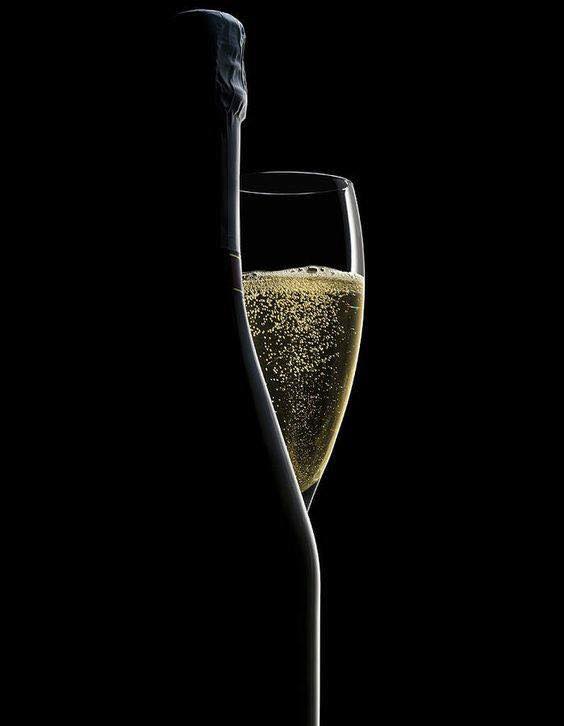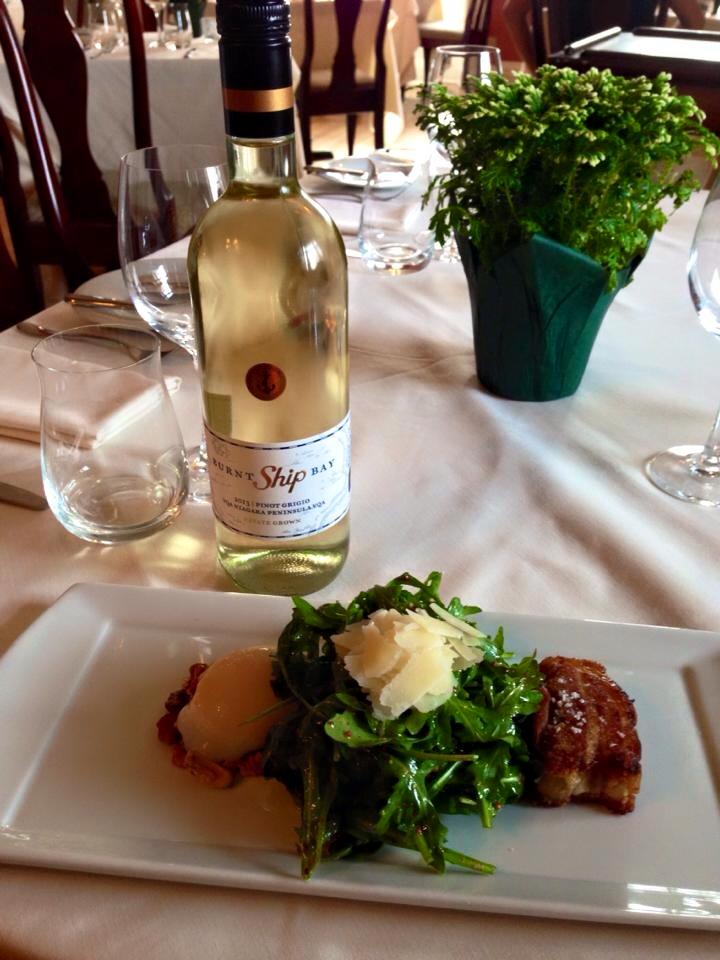
Enjoying Your Wine
Dining Out
Here are the typical steps the server may go through when serving a bottle of wine and how you may wish to respond:
1) They present the bottle, label showing, to the person who ordered the wine. This is just to make sure they brought you the correct bottle.. Check the label to make sure it is what you ordered.
2) They open the bottle and may hand you the cork or place it on the table. If they hand you the cork, you have no obligation to sniff it. If you do, you are simply making sure that the bottom of the cork, where the wine has been in contact, does not smell moldy (like wet cardboard). But you may politely decline when offered the cork and look forward to tasting the wine.
3) The server will then pour 1/3 of a glass of wine for you to taste. This is your chance to determine if the wine is off or not. It rarely will be bad. You can swirl the wine to release the aroma if you like, smell and taste it. If you are not comfortable with these tasting rituals and trust that the wine is fine, you can pass on the tasting and ask that it be served.
Corkage Etiquette
It is increasingly customary in many parts of the country for restaurants to extend corkage policies for patrons who wish to bring their own wine. However, this is not the case everywhere, (especially on the East Coast), and proper wine etiquette dictates that several things should be kept in mind.
Always call the restaurant in advance to verify that corkage is allowed. Also ask what the fee is to avoid any surprises. In my experience, very few restaurants charge over $20 as a corkage fee. Some restaurants will waive this fee if an additional bottle is purchased from the wine list, but do not assume that this is always the case.
Wine brought to a restaurant should be relatively unique or rare, and definitely should not appear on the restaurant's wine list. After the waiter/sommelier opens and pours the contents, proper wine etiquette dictates that you offer them a taste. Following these guidelines will ensure that both you and the restaurant staff are happy.
THE CORRECT GLASS

The choice of glass is as important to the process as the wine you pour into it. An all purpose glass should be clear and long stemmed. It should have a bowl larger than its aperture and the glass must be thin. See Wine Glass
YOUR SENSES
Wine appeals to all five of our senses: sight, smell, taste, touch and even hearing. We are enchanted by the sound of a popping cork and the burst of sparkling wine bubbles. We are affected by eye appeal, the way the wine looks in the glass, its colour and transparency.
SIGHT
Judging a wine by sight is an art in itself. Hold the glass up to the light. All wines should be bright and clean, free of particles or sediment. To tell the alcoholic strength of the wine, swirl the wine in the glass then let it settle. Hold the glass up to the light and look for transparent wetness left on the glass. This will fall back to the surface in "tears" or "legs". The thicker the "legs" and the slower the fall-back, the greater the alcohol content.
SMELL
The nose is much more sensitive than the palate.. The nose will tell you seventy-five percent of what you need to know about a wine. You can taste but four sensations, you can distinguish among 5,000 smells. Once again, swirl the glass which causes the wine's esters to evaporate. The esters carry the aromas. Most people find it difficult to describe what they have smelled. So the first question is "Are there any offensive smells?" Then, "Are the odors pleasant or unpleasant?" If the wine is pleasant, try and relate the smell to something you like. Does it smell fresh, like fresh fruit or berries, nuts or flowers or spicy? Your taste will be affected by the smell.
TASTE
There is not one taste but three : the initial taste as the wine hits your palate, the secondary taste when the wine warms up in the mouth and the aftertaste once you have swallowed the wine. The first impression will be the sweetness in the wine. The sensation is short and intense. Acidity is slower to reveal itself but lasts longer. Note the presence of the taste associated with the smell. Reflect upon the aftertaste. The longer the aftertaste lingers, the better the wine. The taste of wine can be affected by your mood. Romance and wine...perfection.
Use the correct glasses according to the wine served. when possible
Use correct table settings.
Do not smoke at the table.
Decant the wine if sediment is present.
This separates the sediment from the wine and aerates it as well.
Serve the wine at its proper temperature.
Let red wines "breathe."
Cut the capsule (the foil just below the lip of the bottle).
Uncork the wine properly (do not bend the cork).
Pour the cork (about an ounce in a glass).
This checks the wine for colour, texture, and taste, and removes any bits of broken cork out of the wine.
Pair food and wine to complement each other.
Tasting Room Etiquette
In a winery's tasting room, white wines are generally tasted first, followed by reds, and then dessert wines. Within these categories, lighter-bodied wines preceed fuller-bodied ones. Water and crackers may be offered to cleanse the palate between each wine. Correct wine etiquette does not dictate that you must finish every glass. Winery tasting rooms provide jars to dispose of excess wine. Do not feel that you need to sample every wine offered- taste what appeals to you.
If you ask for a second tasting of a particular wine, it is in good manners to buy a bottle. Many wineries charge tasting fees which are generally applied to any purchase. It is not mandatory that you buy wine; purchase only what you desire. That being said, if you have made an appointment at a small winery, it is in good taste to make a purchase. Proper wine etiquette dictates that you not bring children to a tasting room*.
Often the more popular wineries have very crowed tasting rooms be courteous give everyone their opportunity.
* Some wineries offer family activites and enjoy having children visit.
Toasting a history
- I believe the the art of toasting came long before the art of writing
- The Greeks toasted their Gods
- The idea of toasting one's health comes from the Danish who toasted their enemies before beheading them
- The word toasting comes from the 17th century where roasted bread was floated in the wine.
- The clinking of glasses comes from a Christian custom used to ward off the devil
- Today the toast is a gracious salutation to another.
Toasting Etiquette
- Always stand, toasts must be delivered upright while holding the glass straight from your shoulder in your right hand.
- Be prepared, make it short.
- Be positive. Always end with an upbeat note.
- Clearly let others know when to join in the toast.
- The clinking of the glass is done after the spoken toast but before the drinking.
- Always join in, it is better to toast with an empty glass than none at all.
- Toasts are associated with an alcoholic beverage but that's not a requirement.
Some well known toasts
May those who love us,
And those that don't love us,
May God turn their hearts,
and if he doesn't turn their hearts,
May he turn their ankles,
So we'll know them by their limping
An old Irish toast
The wines that one best remembers are not necessarily the finest that one has ever tasted, and the highest quality may fail to delight so much as some far more humble beverage drunk in more favorable surroundings.
H. Warner Allen
Quickly, bring me a beaker of wine, so that I may wet my mind and say something clever.
Aristophanes
"Music is the wine that fills the cup of silence"
Robert Fripp

Wine comes to the mouth
And love comes in at the eye;
That's all we shall know for truth
Before we grow old and die.
I lift the glass to my mouth,
I look at you and,I sigh
-William Butler Yeats
Wine juice in itself is clear. Red is made by laceration of the grapes' skin; the longer the process the deeper the color. You can make white wine from a black grape; for example: the French blanc de noirs.
All that is needed to turn grape juice into wine is the natural process of fermentation. Fermentation is the chemical change of sugar to alcohol.
Left to nature, all wines would be dry but that's where the winemaker introduces his or her experience and skill to the process
Be a page Sponsor
e-mail us and ask how you can be a page sponsor
Home | Sitemap |New | Advertsie | Contact Us |©2018 Robert A Bell/